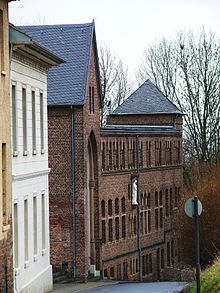Torture chapel
The Marterkapelle, also Mordkapelle, is a church building built between 1719 and 1721 in the Bonn district of Endenich at the foot of the Kreuzberg , which from 1888 belonged to a Benedictine monastery together with other buildings . The band is a short distance from Kreuzbergkirche and as part of the former convent as a monument under conservation . After the dissolution of the Benedictine monastery in 2001, the buildings have been used as the Redemptoris Mater seminary, sponsored by the Archdiocese of Cologne , since 2002 .
history
In the 3rd century, the Roman soldiers of the Theban Legion Cassius and Florentius, along with seven other companions, are said to have been executed here at the foot of the Kreuzberg because of their belief in Christianity .
In 1719 the provost of Bonn's Cassius monastery , Maximilian von Weichs , acquired a piece of land in the area of the alleged place of execution and had a pilgrimage chapel built there to commemorate the martyrdom of the two Bonn saints.
With the consecration of the chapel on August 17, 1721 by the Elector and Archbishop of Cologne, Joseph Clemens , the pilgrimage to the torture chapel began .
As a result of secularization , the chapel began to decline steadily from 1803, so it was used at times as a hayloft and stable.
Only when the property came into the possession of Baroness Caroline von Romberg geb. von Böselager (* 1776; † August 8, 1857), the wife of Baron Gisbert von Romberg , began rebuilding the chapel and adding more buildings. On the initiative of the Baroness, the nuns of the Benedictine Sisters of Perpetual Adoration founded a monastery in 1857 , which they had to leave in 1875. In the so-called Kulturkampf, the nuns received the deportation order and went into exile in Holland .
In 1863 Pauline was born Countess von Fürstenberg-Stammheim. von Romberg (born July 8, 1805 in Münster , † September 5, 1891 in Bonn), daughter of Baroness Caroline von Romberg and wife of Count Franz Egon von Fürstenberg-Stammheim , owner of the property in Bonn-Endenich.
The Countess made the property available to the Benedictine nuns in 1887, who founded their Maria-Hilf monastery here the following year . In the torture chapel, the nuns put up an image of grace “ Our mother of perpetual help ”.
The original torture chapel was integrated into a larger, neo-Gothic style new monastery church in 1892 based on a design by the Bonn architects Becker and Böhm . This, in turn, was connected to the sisters' living quarters by extensions from 1908 to 1915 according to plans by the Bonn architect Max Cronenberg .
The Benedictine nuns also had to leave the monastery around the torture chapel during the Second World War . In 1941 and 1942, the building served as a collection point for 474 Jewish citizens from Bonn and the surrounding area. From here they went to the extermination camps. Only seven are recorded as survivors.
After the war, the nuns were able to continue their monastic life in Endenich from May 1945 until 2001. Then they had to give up the monastery due to the obsolescence and the resulting economic constraints.
The Archdiocese of Cologne has after the acquisition of the monastery in 2002, the seminary " Redemptoris Mater settled, Cologne".
The memory of the martyrs Cassius and Florentius has been preserved in Bonn to this day. Her feast day is October 10th. Every year on the Sunday following October 10th, the Endenich parish moves in a solemn procession from its parish church of St. Maria Magdalena to the torture chapel.
organ
A two-manual organ was built for the Maria-Hilf-Konvent in 1964 by the company EF Walcker, Ludwigsburg (Opus 4708). The instrument is mechanical and is located in the left nave, integrated into the choir stalls.
|
|
|
|||||||||||||||||||||||||||||
- Coupling : Normal coupling: II / I, I / P, II / P
literature
- Peter Jurgilewitsch, Wolfgang Pütz-Liebenow: The history of the organ in Bonn and in the Rhein-Sieg district , Bouvier Verlag, Bonn 1990, ISBN 3-416-80606-9 , pp. 85–86.
Web links
- The place of martyrdom in Endeich , Bonn city patron
- The torture chapel and the former Maria Hilf monastery , Catholic parish of St. Maria Magdalena and Christ's Resurrection
Individual evidence
- ↑ List of monuments of the city of Bonn (as of March 15, 2019), number A 1240
- ^ Wilhelm Passavanti (Ed.): Bonn churches and chapels. History and Art of Catholic Houses of God and Parishes . Bonn 1989, p. 115 .
- ^ Heinz Odenthal: For the 125th birthday of the Bonn architect Max Cronenberg . In: Bonner Geschichtsblätter. Yearbook of the Bonn home and history association . tape 35 , 1984, pp. 179-186 (here: pp. 183/184) .
Coordinates: 50 ° 43 ′ 6.4 " N , 7 ° 4 ′ 39.7" E


